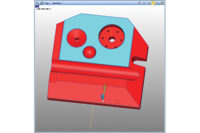Before we explore the question that seems to be on the minds of those in the nondestructive testing (NDT) industry and every other industry these days—Should we move our data to the cloud?—let’s discuss some background on how we got to this point in NDT.
DICONDE
The move to digital imaging and archiving in NDT became official back in 2004 when the American Society for Testing and Materials (ASTM) E07.11 subcommittee made DICONDE (Digital Imaging and Communication for Non-Destructive Evaluation) the standard (E2339-11) for NDT imaging. Based on DICOM (Digital Imaging and Communications in Medicine), a proven imaging and archiving standard since 1993, DICONDE is an imaging and archiving technology standard that defines all image attributes and elements in a universal format. Since DICONDE’s adoption as the standard in NDT, digital converts have been realizing the benefits of digital archiving and workflow.
NDT Digital Archiving
With digital images, a central archive of historical inspection data can be easily created. A central archive makes storing, pre-inspection planning, and post-inspection analysis quicker and more accurate. It also provides a platform for future re-analysis (with newer software tools), or assisting in root cause inquiries. In a digital archive, images are stored with critical metadata (part, revision, inspector) allowing for quick image search, and retrieval.
In terms of archive security, digital is ideal, particularly for highly sensitive information. Digital archiving can ensure only inspectors with a “need to know” are permitted access. Additional image access can be followed with audit trails, showing who looked at what, where, and when, and keeping unauthorized personnel out. Plus, any digital inspection report can be stored with the image data for ease of reference. The data in storage is further safeguarded by mechanisms that verify data integrity, and prevent accidental deletion or changes. And, with a central archive, you can provide a quickly accessible reference point for proving due-diligence when mistakes are later found, or lawsuits occur.
NDT DIGITAL WORKFLOW
With the use of digital (DICONDE) technology, NDT image workflows are simpler and more cost efficient than traditional film workflows, and provide flexibility not available with other proprietary digital workflows. From acquisition to sharing, a digital image workflow improves delivery and report integration for visual and radiographic NDT users. Now to the question of the cloud.
NDT DIGITAL IMAGE STORAGE OPTIONS
When storing DICONDE images there are basically two options to explore—store your images at your own facility, or outsourcing the storage to a third party. The outsourcing is referred to as the cloud. A simple definition of cloud storage can be found on Wiki: “Cloud Storage is a model of data storage where the digital data is stored in logical pools, the physical storage spans multiple servers (and often locations), and the physical environment is typically owned and managed by hosting company. These cloud storage providers are responsible for keeping the data available and accessible, and the physical environment protected and running. People and organizations buy or lease storage capacity from the providers to store user, organization, or application data.”
While the promise of the cloud is very appealing (significantly lower costs through the elimination of a capital investment for hardware and workflow implementation, and ongoing maintenance and associated personnel costs) all industries are apprehensive about putting company data in the cloud. However, if the right questions are asked during provider review, it should make it very easy and inexpensive to start securely storing images in the cloud. Here are some questions to ask potential providers before you make the move:
How do I get my images into the cloud?
Cloud storage can receive images from any DICONDE compliant device. Customers who still produce analog film or have archives of legacy film can simply digitize their film using a scanner then send the scanned (DICONDE) images to the cloud.
What security is in place to protect my images?
Cloud services should provide secure connections, back-ups, and storage. Look for providers that store your data encrypted, both over the Internet and while it is stored. A good provider will also replicate your data to more than just one datacenter to ensure physical redundancy. Ask the provider if they do additional backups to tape vaults, or similar, to minimize the risk of loss.
It’s also best to get a clear written agreement for what will happen if the provider goes out of business or is sold; what is their guarantee against downtime and how you can hold your vendor to their commitments; and what options do they offer to help you migrate to another provider if necessary.
What safeguards are in place to protect the integrity of our images?
A provider’s software should offer a level of integrity checking above basic disk or tape checking. DICONDE files should be “fingerprinted” to ensure that the image you store is the image that you retrieve five, ten, or twenty years down the road. These file “fingerprints” (also known as hashes) can quickly identify unexpected changes to either the image or metadata and should be audited from time to time. Archives should also always retain the original data if an authorized modification is made.
How much does cloud storage cost?
The whole premise of cloud storage is that it’s a very economical way to store data—somebody else maintains the infrastructure. Look for storage providers that offer a “pay-as-you-go” model with little or no upfront capital investment.
How easy is it to share my images?
Sharing images should be as simple as point and click. You should be able to access your stored images in several ways: in the field, on a web viewer using a web browser, or onsite with dedicated DICONDE viewers.
What happens if we want to change cloud providers?
When switching providers, it should be easy to get and transfer your images. You want to ensure that the provider doesn’t highjack or store your images in a proprietary format.
The transition to digital radiography in NDT is fast becoming the norm with demonstrated improved workflows and cost reductions clearing its path. With the same promised benefits, we expect the cloud to become a keystone in the conversion to digital.
Reference Articles
- Quality, April 2014. “Medical Imaging Technology for the Digital Transition of NDT”
- Quality, February 2015. “Benefits of a digital workflow in NDT”



